- Dow and S&P futures slide as tech heavy NASDAQ bears the brunt of the sell-off
- Gold falls proportionate to dollar rise—each testing technical limits
- Bitcoin completes a second consecutive bearish pattern
- Oil finishes bearish rising wedge
- Expectations are ECB will likely hold rates on Thursday, but indicate that downside risks have intensified, suggesting further easing is possible before year-end.
- US CPI data is due Friday, with consumer prices expected to rise in August for a third straight month.
- Futures on the S&P 500 Index gained 0.6%.
- The Stoxx Europe 600 Index advanced 1.6%.
- The MSCI Asia Pacific Index fell 0.3%.
- The MSCI Emerging Markets Index decreased 0.45%.
- The Dollar Index gained 0.8% to 93.13, paring half of its daily advance.
- The euro declined 0.1% to $1.1806.
- The British pound fell 0.2% to $1.3136.
- The Japanese yen was little changed at 106.24 per dollar.
- The offshore yuan was little changed at 6.834 per dollar.
- The yield on 10-year Treasuries fell one basis point to 0.70%.
- The yield on two-year Treasuries dipped less than one basis point to 0.14%.
- Germany’s 10-year yield climbed less than one basis point to -0.47%.
- Britain’s 10-year yield sank three basis points to 0.236%.
- Japan’s 10-year yield declined less than one basis point to 0.037%.
- West Texas Intermediate crude fell 1.8% to $38.80 a barrel.
- Brent crude dipped 1.4% to $41.77 a barrel.
- Gold weakened 0.2% to $1,930.24 an ounce.
Key Events
Monday's Labor Day holiday in the US failed to calm investors' nerves. On Tuesday, futures on three of the four major Wall Street indices fell on ongoing concerns that tech stocks remain overvalued.
Contracts on the Dow, S&P 500 and tech-heavy NASDAQ are under pressure ahead of the start of the US session. Futures on the Russell 2000 were the only contracts in the green, up. 0.14% at the time of writing.
The Stoxx Europe 600 retreated somewhat this morning, after yesterday’s 1.7% jump, its biggest move in almost a month, since Aug 11. The pan-European index was weighed by falling energy companies, as oil futures in London neared a 2-month low on an outlook of short-term demand weakness.
The dollar rose for a fourth day and the currency's strength continued to hold back gold's advance.
Global Financial Affairs
In London, EasyJet (LON:EZJ) plunged as much as 8.2% this morning. The move came after the discount airline announced it will cut flights following the UK government's decision to increase quarantine measures to combat the ongoing COVID pandemic.
The stock has pared losses to 6.3% at the time of writing, but this may be just a prelude to a sharper selloff.
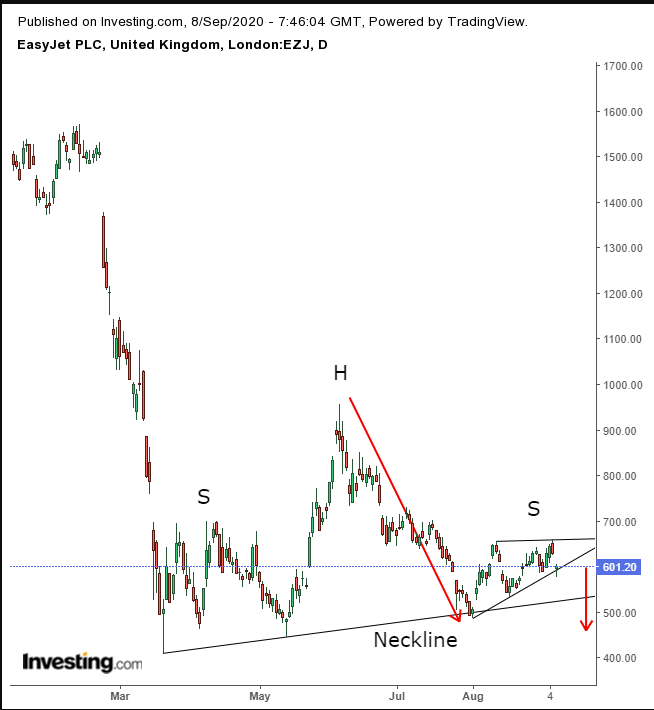
The stock is testing the bottom of a rising wedge, bearish after the preceding plunge, itself the head of a H&S continuation pattern—a pause amid the break-neck plunge provoked by the coronavirus outbreak.
Earlier Tuesday, Asia was flashing green across the board, despite President Donald Trump's threat to sharply cut his country’s economic relationship with China.
Australia’s ASX 200 outperformed, (+1.1%), after a report that the country would force banks to increase debt to aid stimulus and offset the pandemic’s severe impact on the economy.
We’ve repeatedly noted that Chinese investors seem to almost always deflect geopolitical challenges with the US, which was the case once again today. The Shanghai Composite added 0.7%, slightly less than its regional neighbor, South Korea's KOSPI.
Regional investors were said to have sought bargains among heavyweight financials after a four-day straight selloff of the mainland index. However, from a technical perspective, these dip-buyers may have just joined a short squeeze before a deeper plunge.

The index blew out what should have a been a bullish Ascending Triangle, flipping market dynamics and sentiment. Indicators support that breakdown.
US yields fell after reaching the Aug. 12 high.
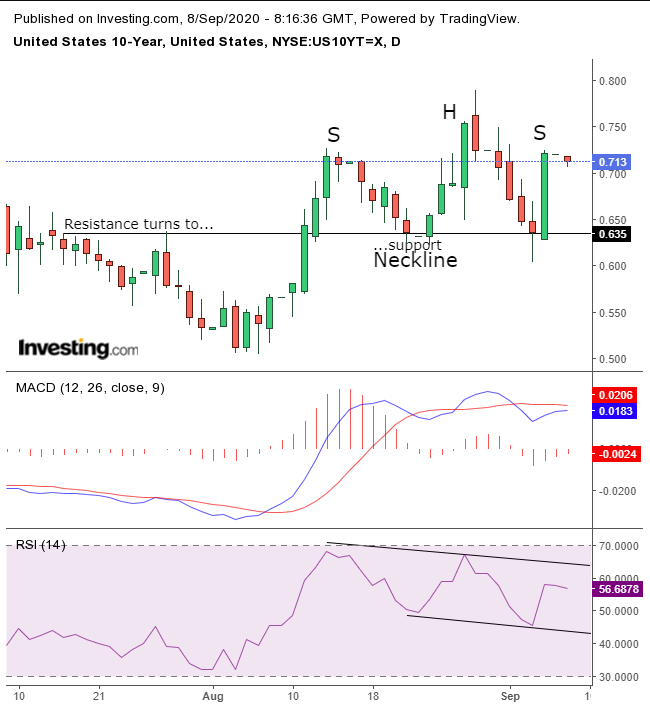
The 10-year Treasury developed a H&S top pattern with indicators supporting a decline.
The dollar rose for the fourth day of five. However, it retreated from the session highs, after yields peaked.
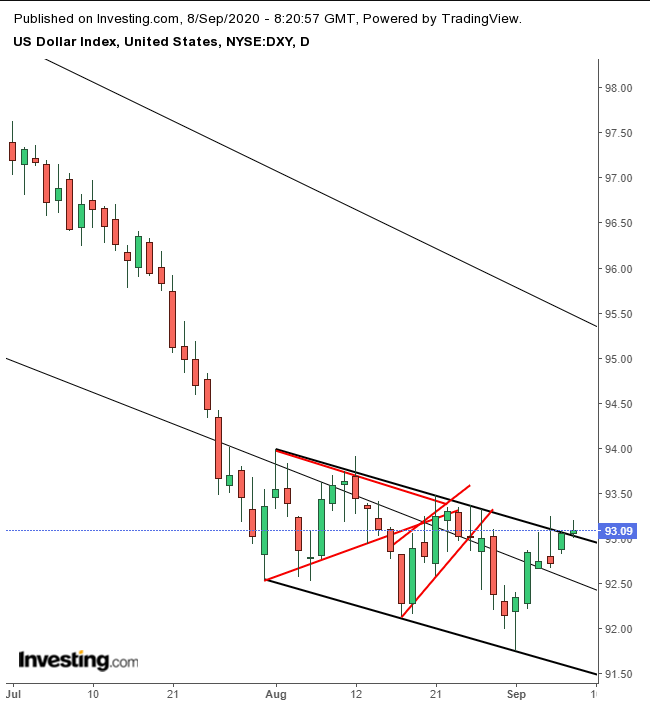
Technically, it is severely testing the top of its falling channel since August and the bottom of the falling channel, the Mar. 19 high, at the same time that it's testing Thursday’s shooting star and back-to-back bearish patterns, a pennant and a flag.
The dollar rally weighed on gold, pushing the precious metal lower for the corresponding four days out of five. Technically, traders have tough choices ahead of them.
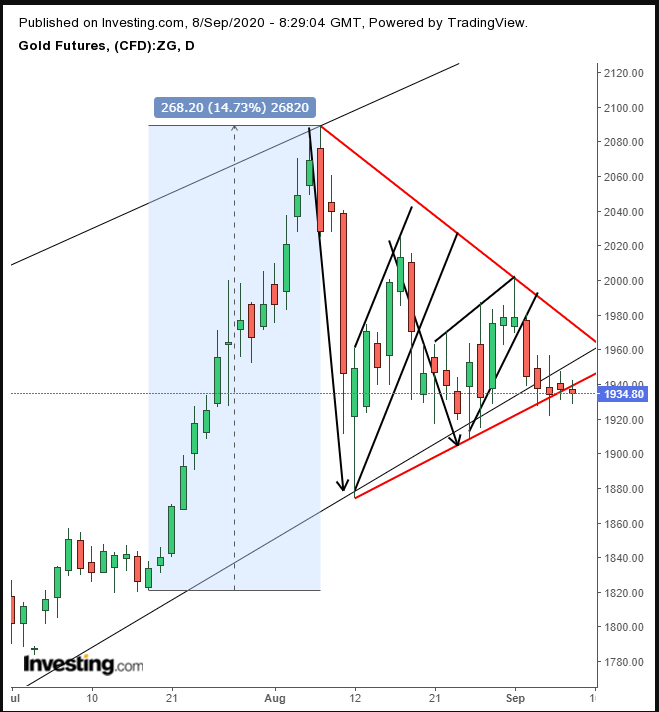
Gold is adamantly testing and retesting the bottom of a pennant that fits the rising channel like a glove. On the other hand, the yellow metal may have completed back-to-back rising flags, bearish after preceding drops.
Which trend will win, the long-term trend represented by the pennant inside the rising channel or the short-term trend, manifested by the consecutive flags? While no one can know for sure, we’re betting on the long-term.
From a risk-reward perspective, there's a small risk with a close stop-loss. This could produce incredible results with a far target.
Bitcoin may be developing a pennant.
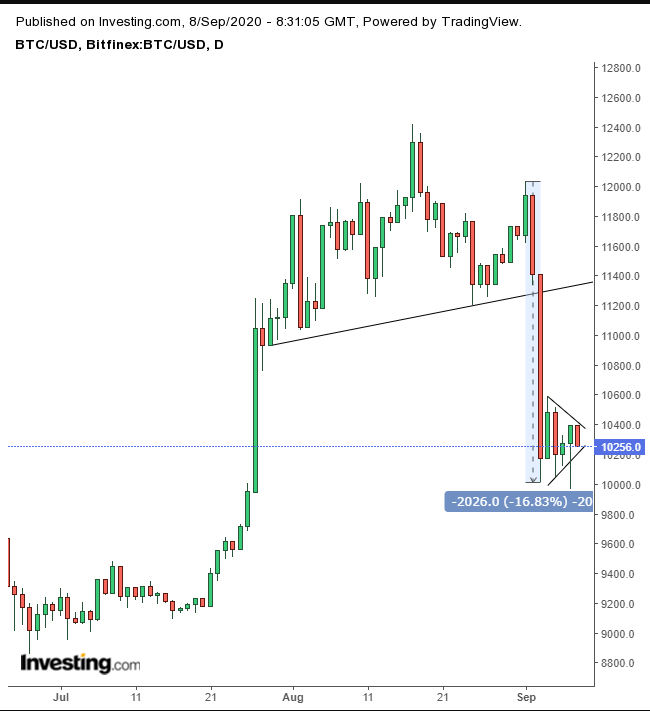
This would be bearish after the cryptocurrency's amazing, near-17% plunge in two days that completed a H&S top.
Oil fell for the eighth day out of nine, dropping below a two-month low on a bleak demand outlook.
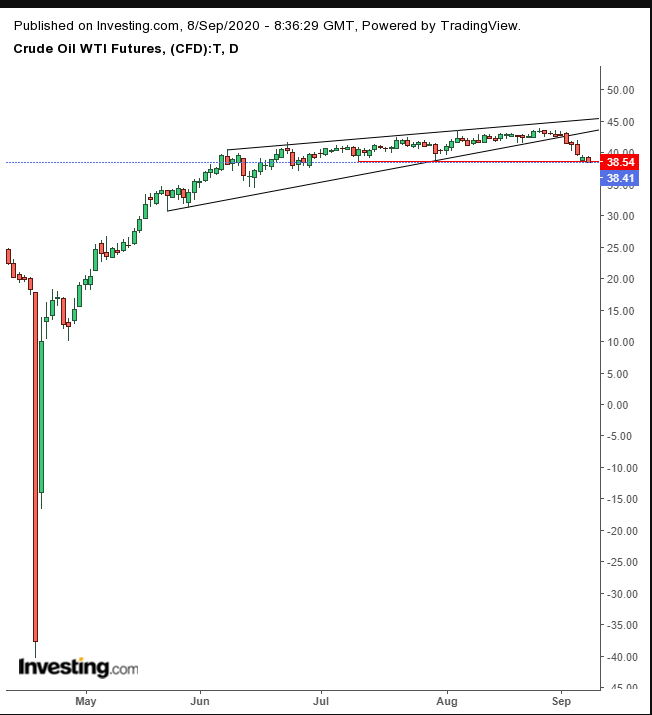
WTI is retesting the $38 support since July 10 after completing a rising wedge, bearish after the upward climax from sub-zero, -$40 levels to +$40 territory.
The fact that the commodity couldn’t maintain that fantastical trajectory disappointed investors who were chasing the price.
Up Ahead
Market Moves
Stocks
Currencies
Bonds
Commodities
